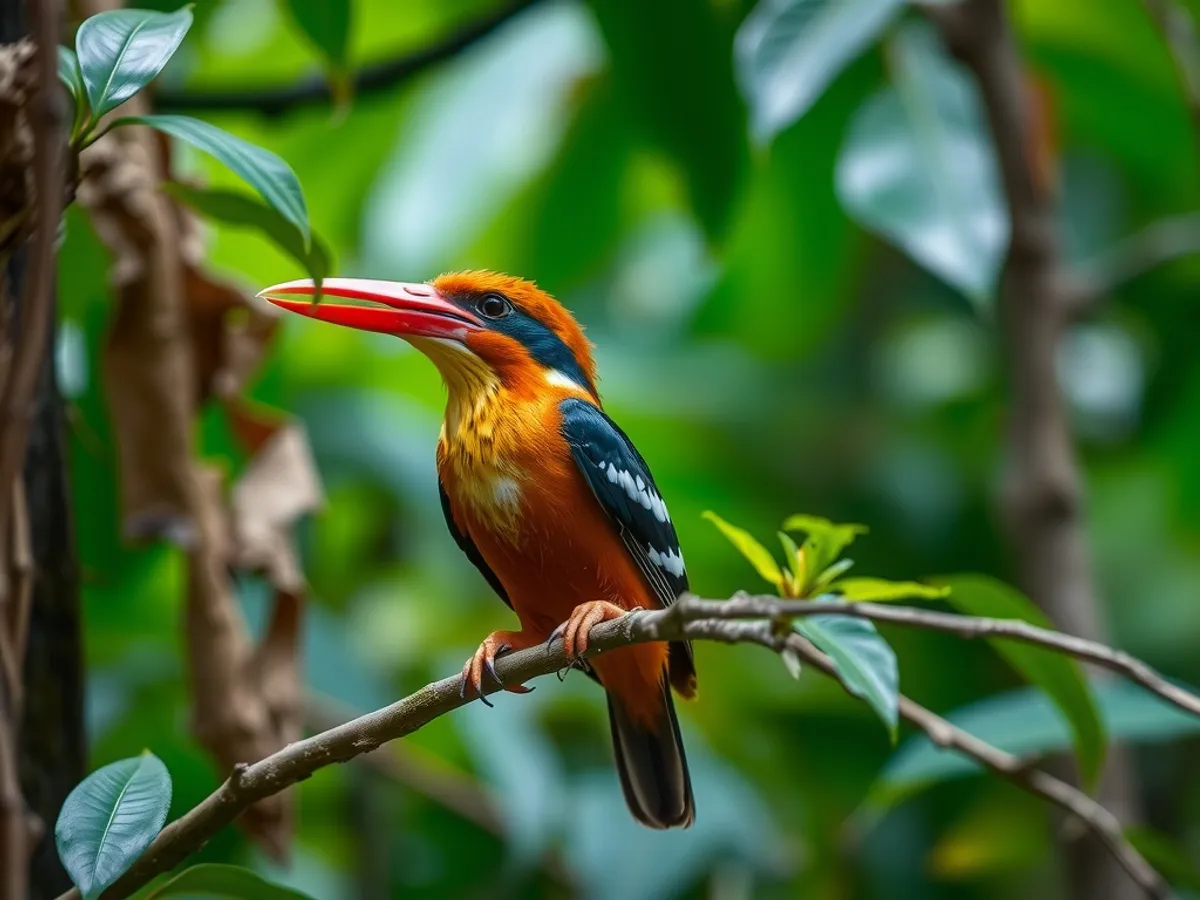
Yellow-billed Kingfisher
Syma torotoro

Meet the Yellow-billed Kingfisher
The Yellow-billed Kingfisher is a brightly colored, medium-sized bird native to the rainforests and woodlands of New Guinea and northern Australia. It is easily recognized by its vivid golden-yellow bill, rich orange underparts, and greenish-blue upperparts. This species is known for its loud, ringing calls, often heard early in the morning or at dusk. The Yellow-billed Kingfisher spends much of its time perched quietly in dense foliage, waiting to catch insects, small reptiles, and other prey.
Classification
Bird
Habitat
Tropical and subtropical lowland rainforest
Diet
Carnivore
Lifespan
5-8 years
Conservation
Least Concern
Weight
35-50 g
📖Fascinating Facts
Distinctive Call
The Yellow-billed Kingfisher's call is a loud, repetitive whistle, which can be heard echoing through rainforest canopies at dawn and dusk.
Unusual Nesting Site
They excavate nesting chambers inside active arboreal termite mounds, taking advantage of the mound’s protection and stable temperature.
Colorful Plumage
Their striking plumage features a bright yellow bill, orange underparts, and greenish-blue upperparts, making them highly distinctive among kingfishers.
📋Detailed Description
The Yellow-billed Kingfisher (Syma torotoro) is a striking, medium-sized kingfisher, measuring approximately 20–23 cm in length and weighing around 40–50 grams. Its most distinctive feature is the robust, bright yellow bill, which contrasts with the deep orange to rufous underparts and the olive-green to blue-green upperparts. The crown and nape are often tinged with a golden or orange hue, and the wings and tail exhibit a subtle iridescence. Sexual dimorphism is minimal, though females may be slightly duller in coloration. The species has short legs and syndactylous toes (two or more toes fused), aiding in perching and prey handling. Its eyes are large and adapted for excellent visual acuity, essential for detecting prey in dim rainforest understory. The Yellow-billed Kingfisher is primarily arboreal, spending most of its life in the mid to lower canopy of lowland rainforests, forest edges, and secondary growth. It is generally solitary or found in pairs, exhibiting territorial behavior. The bird's loud, whistling call is a key feature of its dawn and dusk activity, serving both territorial and mate-attraction functions. Its flight is swift and direct, with rapid wingbeats interspersed with short glides.
💡 Did you know?
Despite their name, Yellow-billed Kingfishers rarely eat fish and instead primarily feed on insects and small vertebrates.
🔬Research & Sources
Wikipedia Summary
The yellow-billed kingfisher (Syma torotoro) is a medium-sized tree kingfisher.
Last Modified: 5/29/2024
🎭Behavior & Social Structure
Yellow-billed Kingfishers are sit-and-wait predators, often perching motionless on low branches or vines within dense foliage. They scan the forest floor or understory for movement, then swoop down to seize prey with their strong bills. Their diet consists mainly of large insects (such as beetles, grasshoppers, and cicadas), spiders, centipedes, and small vertebrates like lizards and occasionally frogs. They have been observed using their bills to probe into leaf litter or bark crevices. Socially, they are territorial and will defend their feeding and nesting areas with vocalizations and aggressive displays. Outside the breeding season, individuals are mostly solitary, but pairs may remain loosely associated. Their daily routine includes periods of intense activity at dawn and dusk (crepuscular), with midday hours spent resting or preening in shaded cover.
👶Reproduction & Life Cycle
Breeding generally occurs during the wet season, which varies regionally but often spans from October to March. Yellow-billed Kingfishers are monogamous during the breeding season, with pairs forming stable bonds. Courtship involves vocal duets, mutual preening, and food offerings. Unlike many kingfishers, this species nests in arboreal termite mounds, excavating a horizontal tunnel and chamber where the female lays 2–3 glossy white eggs. Both parents participate in incubation, which lasts about 18–20 days, and in feeding the altricial chicks. Fledging occurs approximately 22–25 days after hatching. Parental care is intensive, with adults bringing a variety of prey to the nestlings. After fledging, juveniles remain dependent on parents for several weeks before dispersing.
🛡️Adaptations & Survival
The Yellow-billed Kingfisher displays several adaptations for its forest environment. Its bright bill and plumage may serve as visual signals in dense foliage, aiding mate recognition and territorial displays. The syndactylous toes provide a strong grip for perching and manipulating prey. Its large eyes are adapted for low-light conditions, enhancing hunting efficiency during crepuscular hours. The use of arboreal termite mounds for nesting offers protection from ground predators and stable microclimates for egg incubation. Its vocalizations are adapted to carry through dense vegetation, ensuring effective communication over territory and mate location.
🎨Cultural Significance
The Yellow-billed Kingfisher holds a modest place in local folklore and indigenous traditions in New Guinea, where its distinctive calls are sometimes associated with omens or seasonal changes. In some regions, the bird is considered a messenger of the forest, and its presence is noted by birdwatchers and naturalists for its beauty and elusive habits. However, it does not have significant economic or symbolic importance in broader human culture compared to some other kingfisher species.
🔬Recent Research & Discoveries
Recent research has focused on the species' nesting ecology, particularly its unique use of termite mounds, which is relatively rare among kingfishers. Studies have examined the microclimate regulation within termite nests and its benefits for egg and chick survival. Genetic analyses have clarified the relationships within the Syma genus, supporting the distinction of three subspecies (S. t. torotoro, S. t. flavirostris, and S. t. ochracea) based on geographic distribution and subtle morphological differences. Ongoing monitoring in New Guinea and Australia is tracking population trends in response to habitat change. Bioacoustic studies are also investigating the structure and function of their vocalizations in dense rainforest environments.
🎥Wildlife Videos

Yellow-billed Kingfisher facts 🦜
The yellow-billed kingfisher is a medium-sized tree kingfisher. It is known to prey on large insects, earthworms, and small snakes ...
Amazing Planet!

Kingfishers - The Gift of Nature (flying rainbow) | Go Wild
The Oriental Dwarf Kingfisher is one of the most enigmatic and rarely filmed birds in the world. This fascinating documentary ...
Go Wild

Kingfisher - The Hunt for Germany's Flying Diamond | Free Documentary Nature
Kingfisher - The Hunt for the Flying Diamond | Free Nature Documentary This is the story of an animal filmmaker who fulfilled a ...
Free Documentary - Nature

Yellow Billed Kingfisher
Yellow Billed Kingfisher on 2017 Inala Cape York Tour.
Inala Nature Tours

Yellow-billed Kingfisher, by Christina N. Zdenek
Filmed in HD by C.N.Zdenek. Special thanks to Brian Venables. https://cnzdenek.wixsite.com/cnzdenek.
Dr Christina N. Zdenek

Yellow kingfisher #shorts #short #viralshorts #youtubeshorts #tiktok #documentaryshort #shortvideo
Documentary short
🌍Habitat Information
The Yellow-billed Kingfisher typically inhabits Tropical and subtropical lowland rainforest environments. Yellow-billed Kingfishers have adapted to their environments with specialized features and behaviors.
Primary Habitat:
Tropical and subtropical lowland rainforest
More detailed habitat information will be available soon.
🛡️Conservation Status
The Yellow-billed Kingfisher is currently classified as Least Concern. Conservation efforts are crucial for preserving this species for future generations.
Common Threats:
- 🏠Habitat loss and fragmentation
- 🌡️Climate change impacts
- 🎯Hunting and poaching
- 🏭Human-wildlife conflict
⚠️Threats & Conservation Challenges
Currently assessed as Least Concern by the IUCN, the Yellow-billed Kingfisher faces localized threats from habitat loss due to logging, agricultural expansion, and forest fragmentation, particularly in lowland areas. While populations remain stable in extensive tracts of undisturbed forest, ongoing deforestation in New Guinea and northern Australia could pose future risks. The species is sensitive to habitat quality and rarely persists in heavily degraded landscapes. There is limited evidence of direct human persecution, but climate change and increased frequency of extreme weather events may impact breeding success and prey availability.
🔬Scientific Classification
Scientific Name
Syma torotoro
Classification Hierarchy
🔍 About Taxonomic Classification
Taxonomic classification is a hierarchical system used by scientists to classify and organize living organisms based on shared characteristics and evolutionary relationships.
The system moves from broad categories (Kingdom) to increasingly specific ones, with each animal's scientific name typically consisting of its Genus and species.
📝Community Notes
Share your observations and insights about the Yellow-billed Kingfisher with our community of wildlife enthusiasts.
Join Our Community
Sign in to share your observations and connect with fellow wildlife enthusiasts.
Sign In to ContributeNo community notes yet
Be the first to share your observations about the Yellow-billed Kingfisher!
Explore Yellow-billed Kingfisher
Select a tab above to learn more about this amazing animal.
📸Photo Gallery
No photos available for this animal yet.
🌟Discover More Wildlife
Continue your journey of discovery with more fascinating animals from our database
